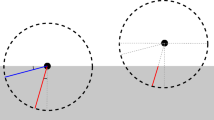Abstract
The material point method (MPM) has proved to be an effective particle method for computational mechanics modeling of problems involving contact, but all prior applications have been limited to Coulomb friction. This paper generalizes the MPM approach for contact to handle any friction law with examples given for friction with adhesion or with a velocity-dependent coefficient of friction. Accounting for adhesion requires an extra calculation to evaluate contact area. Implementation of velocity-dependent laws usually needs numerical methods to find contacting forces. The friction process involves work which can be converted into heat. This paper provides a new method for calculating frictional heating that accounts for interfacial acceleration during the time step. The acceleration terms is small for many problems, but temporal convergence of heating effects for problems involving vibrations and high contact forces is improved by the new method. Fortunately, the new method needs few extra calculations and therefore is recommended for all simulations.









Similar content being viewed by others
References
Akhavan J (2011) The chemistry of explosives. Royal Society of Chemistry, London
Bardenhagen SG, Brackbill JU, Sulsky D (2000) The material point method for granular materials. Comput. Methods Appl Mech Eng 187:529–541
Bardenhagen SG, Brackbill JU, Sulsky DL (1998) Shear deformation in granular material. In: Proceedings of the 11th international detonation symposium, Snowmass Village, Colorado, pp 528–536
Bardenhagen SG, Guilkey JE, Roessig KM, Brackbill JU, Witzel WM, Foster JC (2001) An improved contact algorithm for the material point method and application to stress propagation in granular materials. Comput Model Eng Sci 2:509–522
Bardenhagen SG, Kober EM (2004) The generalized interpolation material point method. Comput Model Eng Sci 5:477–496
Field JE (1992) Hot spot ignition mechanisms for explosives. Acc Chem Res 25(11):489–496. doi:10.1021/ar00023a002
Guo Y, Nairn JA (2006) Three-dimensional dynamic fracture analysis in the material point method. Comput Model Eng Sci 16:141–156
Homel M, Herbold EB (2016) Field-gradient partitioning for fracture and frictional contact in the material point method. Int J Numer Methods Eng 109(7):1013–1044
Huang P, Zhang X, Ma S, Huang X (2011) Contact algorithms for the material point method in impact and penetration simulation. Int J Numer Methods Eng 85(4):498–517. doi:10.1002/nme.2981
Lemiale V, Hurmane A, Nairn JA (2010) Material point method simulation of equal channel angular pressing involving large plastic strain and contact through sharp corners. Comput Model Eng Sci 70(1):41–66
Nairn JA (2003) Material point method calculations with explicit cracks. Comput Model Eng Sci 4:649–664
Nairn JA (2007) Numerical implementation of imperfect interfaces. Comput Mater Sci 40:525–536
Nairn JA (2013) Modeling of imperfect interfaces in the material point method using multimaterial methods. Comput Model Eng Sci 92(3):271–299
Nairn JA, Guilkey JE (2015) Axisymmetric form of the generalized interpolation material point method. Int J Numer Methods Eng 101:127–147
Pan XF, Xu AG, Zhang GC, Zhang P, Zhu JS, Ma S, Zhang X (2008) Three-dimensional multi-mesh material point method for solving collision problems. Commun Theor Phys 49:1129–1138. doi:10.1088/0253-6102/49/5/09
Sewell TD, Menikoff R, Bedrov D, Smith GD (2003) A molecular dynamics simulation study of elastic properties of hmx. J Chem Phys 119:7417–7426
Sulsky D, Chen Z, Schreyer HL (1994) A particle method for history-dependent materials. Comput Methods Appl Mech Eng 118:179–186
Wilkens ML (1999) Computer simulation of dynamic phenomena. Springer, New York
Williams JG, Patel Y, Blackman BRK (2010) A fracture mechanics analysis of cutting and machining. Eng Fract Mech 77(2):293–308
Acknowledgements
This work was funded by a Small Business Technology Transfer (STTR) contract with Eglin Air Base Contract #FA8651-15-M-0298.
Author information
Authors and Affiliations
Corresponding author
Ethics declarations
Conflict of interest
On behalf of all authors, the corresponding author states that there is no conflict of interest.
Additional information
DISTRIBUTION A. Approved for public release, distribution unlimited. (96TW-2016-0188).
Appendix
Appendix
For the sliding block problem in Fig. 2 the sliding traction for \(t>t_2\) is:
where \(t_s=t_f-t_2\) is total time for increasing tangential force. The sliding will start when this traction reaches the zero-velocity sliding force using the static coefficient of friction (\(\mu _s N + S_a\)), which occurs when
Once sliding begins, the total force in the x direction is \(F_t-lb\bigr ((\mu _d + k v(t))N + S_a\bigl )\), which leads to an acceleration of:
where
Solving the above differential equation for v(t), the sliding velocity is
where
The total friction work is
For \(k=0\), the result is
For \(k\ne 0\), the result is
Rights and permissions
About this article
Cite this article
Nairn, J.A., Bardenhagen, S.G. & Smith, G.D. Generalized contact and improved frictional heating in the material point method. Comp. Part. Mech. 5, 285–296 (2018). https://doi.org/10.1007/s40571-017-0168-1
Received:
Revised:
Accepted:
Published:
Issue Date:
DOI: https://doi.org/10.1007/s40571-017-0168-1




